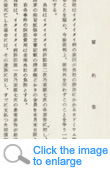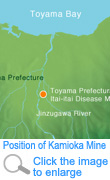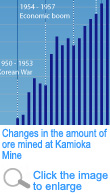安全・安心情報
トップページ > くらし・健康・教育 > 健康・医療・福祉 > 医療 > イタイイタイ病資料館 > 利用案内 > The Itai-itai Disease museum > The Itai-itai Disease museum《FloorPlan》 > Investigation of causes, and moves for protecting health and lives
更新日:2021年3月25日
ここから本文です。
Investigation of causes, and moves for protecting health and lives
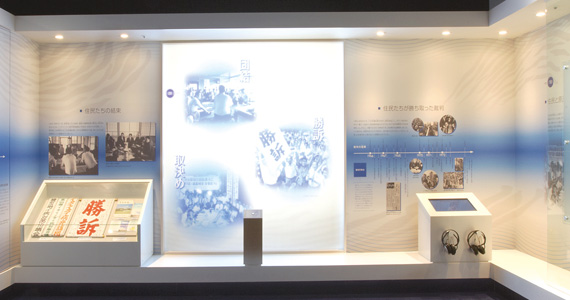


Various theories were given as to the cause of Itai-Itai Disease, but the residents, who had suffered for a long time, went to court demanding a solution for health damage caused by the cadmium released from Kamioka Mine. The residents won the case, helped in part by government opinion, and the struggle for cause investigation came to an end. At once, residents and Mitsui Mining and Smelting Co. made an agreement to start efforts toward relieving victims and restoring the environment.
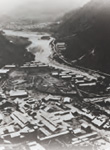
Mitsui Mining & Smelting Company Kamioka Mine Photo Book


The disease of unknown cause that had inflicted pain on residents in the basin of the Jinzugawa River was introduced in newspapers as “Itai-itai Disease” in 1955. Furthermore, the disease had started to attract attention because it had been discussed by the Japan Surgical Association. Thus, a great many researchers, including those at the prefectural and national levels, began to actively conduct research in an attempt to locate the cause of the disease.

In early studies, theories were focused on the idea that overwork and malnutrition were causing the disease.
Eventually, it was determined that the cause of the disease was discharge from Kamioka Mine, the so-called “mineral poison theory.” In 1961, a further theory stated that cadmium discharged from the mine was behind the disease.
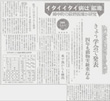
A newspaper article on the academic announcement concerning Itai-itai Disease and cadmium Kitanippon Newspaper June 24,1961

In 1968, the Ministry of Health and Welfare gave their opinion in which they stated they could find no other explanation than that Itai-itai Disease was caused by chronic cadmium poisoning with this cadmium being discharged from Kamioka Mine. This was the first time that the government had officially announced that pollution was a health hazard. This was a ground-breaking development.
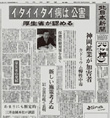
A newspaper article on the Ministry of Health and Welfare Opinion that Itai-itai Disease was caused by pollution Kitanippon Newspaper May 9,1968


In 1966, the victims, their families and the bereaved established the Council of Countermeasures for Itai-itai Disease to seek solutions and relief from health damages. The residents united to start a movement toward demanding reparations from Mitsui Mining & Smelting Company, which operated Kamioka Mine, and to petition the prefectural and national governments for relief aid.

Residents filed the lawsuit against Mitsui Mining & Smelting Company in 1968, and they won the case at the first trial of 1971, the first time citizens had ever won against a company for a pollution-related illness suit in Japan. Then, the residents’ side won again at the second trial in 1972. This suit was, at that time, of an unprecedentedly large scale in Japanese legal history; the victims’ participation ratio was high, reaching 506 plaintiffs.



At the trial, the major point of issue was the causal relationship between Itai-itai Disease and the cadmium discharged by Kamioka Mine.
The residents asserted that there was a causal relationship with mine pollution based on the fact that the place and time where Itai-itai Disease occurred was limited and the fact that the region in which the disease occurred matched up with the region that had suffered agricultural damage.
On the other hand, Mitsui Mining & Smelting Company argued against this with the claim that it was not possible to say there was a causal relationship because cadmium’s effect on the human body and its mechanism had not been clarified.


The day after the second trial when the residents’side won the suit, residents visited the Head Office of Mitsui Mining & Smelting Company to directly conduct negotiations. The parties signed agreements and promissory letters regarding three issues: prevention of public hazard, recovery from land pollution, and compensation to the victims. The agreement for the prevetion of public hazard was especially ground-breaking, and included stipulations that the company accept on-site inspections of Kamioka Mine by residents. This marked the first step to take back the beautiful Jinzugawa River.

Kamioka Mine is located on the right bank of the Takaharagawa River (which becomes the Jinzugawa River after passing the border into Toyama Prefecture), whose riverhead is in the Northern Alps near the border between Toyama and Gifu prefectures. This mine produces mainly zinc and lead. Its history is very long and there is record of mining beginning in the 8th century. In 1874, Mitsui-gumi (later Mitsui Mining & Smelting Company) took over management, and it became a major source of zinc and lead supporting Japanese modernization.

Cadmium is a heavy metal widely found in nature. It is contained in relatively high concentrations in zinc ore.
Cadmium was found in the water from the mine generated in the production process of zinc and in wastewater coming out from the smelter and the slag dump.

Since the 1870s, the technology to extract zinc from the mineral ore had progressed, and due to the demand triggered by war (such as the Russo-Japanese War and World War II), a huge volume of mineral ore was mined to expand zinc production.

As for zinc and lead, Kamioka Mine ceased mining minerals in 2001, and is now refining the zinc from imported mineral ore, and the lead from recycling car batteries. In addition, they also recycle the precious metals (gold and silver) used in personal computers and mobile phones.
お問い合わせ
関連情報
より良いウェブサイトにするためにみなさまのご意見をお聞かせください

